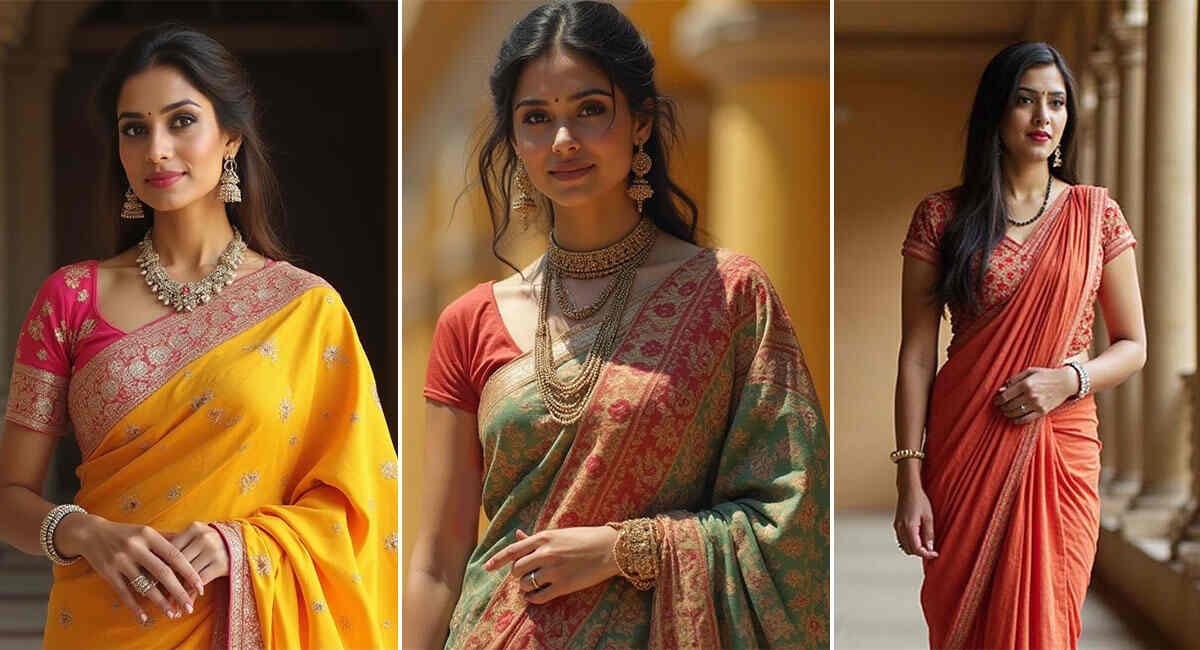Six Yards of Grace: The Saree Story!
When you think of Indian fashion, one outfit that never goes out of style is the saree. It’s elegant, versatile, and a proud symbol of our heritage. But do you know how this iconic garment came into being and how it has evolved over the years? Let’s take a beautiful journey through time to explore the story of the saree and how it began, changed, and stayed timeless.
Saree comes from the Sanskrit word śātī, which simply means a piece of cloth. Over the centuries, the term evolved from śātī to Sati and finally to what we now know as the Saree. Believe it or not, this garment dates back to the Indus Valley Civilization nearly 5000 years ago! In ancient times, women didn’t wear a blouse or a petticoat with the saree. It was a two-piece outfit; one side wrapped around the lower body, and the other draped across the upper body. Think of it like the original version of mix-and-match!
The saree, beyond being a fashion statement, was a practical solution to India’s climate. The saree met the hotter regions, makingneed hotter areas, made it necessary to wear clothes that allowed air circulation while protecting the skin. Even scientists agree that the pallu, when draped over the arms and shoulders, helps insulate the body by about 40%. If you just let the pallu rest on your shoulder, it can cool you down. So yes, our grandmothers had style but also science on their side!
The saree’s diversity is fascinating, with draping styles varying from region to region. Each state has its unique flair, from the elegant Nivi style of Andhra Pradesh to the traditional Bengali or Maharashtrian drapes. These styles evolved, adapting to changing trends. The Mughal era saw women pleating their sarees more elaborately, while the glam 50s and 70s saw Bollywood divas flaunting flowy, non-pleated sarees with dramatic flair. Today, the pleated saree is back with a bang, paired with heels, boots, flats, or even sneakers!
Back in the day, women wore sarees without a blouse. However, when British influence kicked in during colonial times, blouses became a part of the attire, initially a mark of modesty. Fast forward to now, and the blouse has become a fashion statement. From backless, strapless, halter-neck to puffed sleeves, there’s a blouse for every mood and moment!
Traditionally, sarees were nine yards long; quite a task to handle, right? But with changing lifestyles and the need for convenience, sarees became shorter, usually six or seven yards. They are easier to drape, lighter to carry, and perfect for modern women on the go.
Once upon a time, silk ruled the saree world. Worn for festivals, weddings, and religious functions, silk sarees were the go-to option. But modern preferences have shifted towards lighter, more breathable fabrics like cotton, georgette, chiffon, ikat, and net. These fabrics are easier to wear, especially for daily or office use. Plus, they come in so many prints and colors that your wardrobe can never get boring.
Thanks to advancements in dyeing and weaving, designers now have endless options to play with. Handlooms, digital prints, eco-friendly dyes; you name it, it’s available. And this has created a thriving industry, giving countless artisans, weavers, and small businesses a livelihood.
From ramp walks in Paris to street styles in Mumbai, the saree is making waves worldwide. It’s no longer just traditional wear. Celebs pair it with belts, jackets, and sneakers; you can go full Desi or Fusion, depending on your vibe. And thanks to the power of social media, draping tutorials, and styling tips, the saree has become more accessible and trendy, making everyone a part of its modern journey.
One of the most beautiful things about the saree is how it’s passed down from generation to generation. Your mumma’s wedding saree, your grandma’s silk beauty, that heirloom Banarasi. It’s memories, love, and legacy stitched into six yards.
So, whether you’re draping it for a wedding look, a work meeting, or a casual brunch, the saree has your back, literally and fashionably. From history to haute couture, the saree has come a long way, and yet, it’s right where it belongs, close to our hearts!


